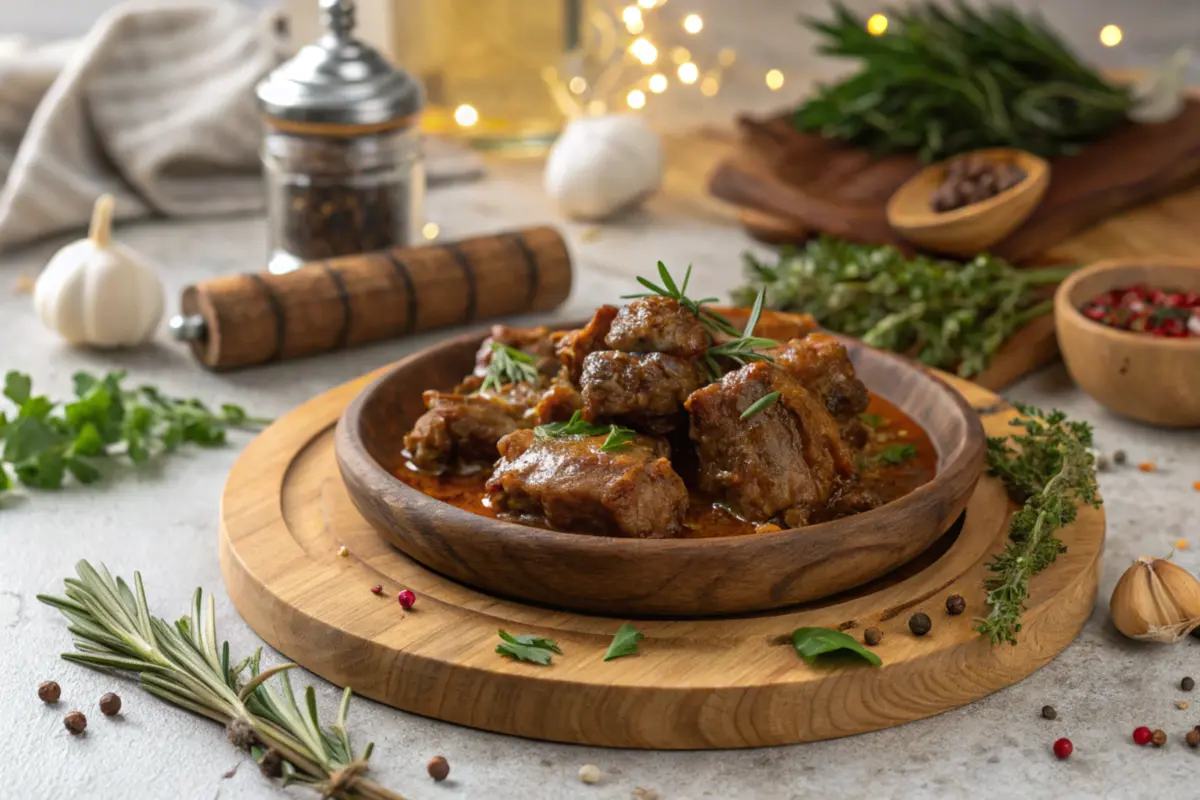Discover how to transform turkey necks into delicious, nutritious meals with simple techniques, seasoning tips, and serving suggestions.
If you think turkey necks are only for basic stock or gravy, think again. These underrated cuts deserve a starring role in your kitchen. In this comprehensive guide, you’ll learn how to select, prepare, and cook turkey necks using braising, slow-cooking, and other methods that transform ordinary poultry into something truly special. You’ll also discover how to highlight their savory richness, create memorable turkey neck recipes, and serve balanced meals that incorporate these flavorful cuts.
Understanding turkey necks
Turkey necks may not receive as much attention as more common poultry parts, but they’re packed with robust flavor and incredible potential. Because this area of the bird works hard, the meat develops a pleasantly firm texture that becomes tender with the right preparation. Comparatively, fresh ones have a subtle taste, while smoked versions, often seen in turkey neck dishes, add a richer, more complex note.
You can often find turkey necks at butcher shops or specialty markets, either fresh or smoked, making them perfect for experimentation. Indeed, these cuts can shine as the main protein in your favorite turkey neck recipes or add depth to soups, stews, and gumbo. Consequently, learning the art of cooking turkey necks broadens your culinary horizons.
Selecting Quality turkey necks at the Market
When choosing high-quality turkey necks for your next dinner, look for pieces with a fresh, appealing appearance. Accordingly, the meat should appear pinkish without unpleasant odors. Because freshness matters, buy from reputable butchers or markets that handle poultry with care.
If possible, consult your butcher for advice on which turkey necks suit your chosen cooking style. Undoubtedly, their insights can guide you to premium options. Eventually, recognizing vibrant color and mild aroma will become second nature, ensuring any turkey neck recipes you try result in memorable meals.
Nutritional Profile
These meaty neck segments offer protein and essential minerals, making them a valuable addition to various turkey neck dishes. Comparatively, they tend to have fewer calories than fattier cuts, so they can fit into a balanced eating plan. Incorporating them into your routine provides a welcome departure from standard poultry choices.
Additionally, slow-cooking or braising turkey necks releases collagen and gelatin, creating nourishing broths perfect for a range of turkey neck recipes. Moderation is still important, but diversifying your protein sources with these savory cuts can add both flavor and nutrients to your diet.
How to Cook turkey necks
Mastering the techniques for cooking turkey necks opens the door to countless possibilities. Initially, decide what texture and flavor profile you want. Braising yields fork-tender results, while a slow cooker produces melt-in-your-mouth goodness. Because these cuts respond best to gentle, moist heat, roasting at high temperatures usually isn’t ideal.
Instead, simmering or slow-cooking turkey necks allows their connective tissues to break down, resulting in succulent bites. Eventually, you’ll develop preferences for certain turkey neck recipes, such as a hearty stew or a rich gravy base. Another tip: season with salt, pepper, and aromatics before starting, ensuring the flavors build as you cook.
Braising Techniques for turkey necks
Braising is a classic approach for turning turkey necks into tender, satisfying dishes. Basically, begin by browning the pieces in a small amount of oil until caramelized. Afterward, add onions, garlic, and other aromatics. Next, deglaze the pot with wine or broth to capture those savory browned bits.
Subsequently, return the necks to the pot, cover, and simmer until fully tender. Generally, this takes a couple of hours. Eventually, the low heat coaxes out incredible depth, making braised turkey neck recipes a comforting and flavorful choice. Experiment with herbs, mushrooms, or a touch of vinegar to personalize your dish.
Slow-Cooking Methods
A slow cooker or Instant Pot provides a convenient path to delicious turkey neck dishes. Chiefly, place the necks with broth, herbs, and vegetables in the cooker, then let them simmer for hours. Consequently, you’ll return to a satisfying meal infused with rich, homey flavors.
Additionally, consider adding paprika, bay leaves, or thyme to your turkey neck recipes. A bit of soy or Worcestershire sauce can deepen the savory notes. Indeed, layering flavors in stages—sautéing onions first or adding fresh herbs near the end—further refines your results. Cooking turkey necks slowly ensures tenderness and complexity.
Flavor Variations for turkey necks
Because turkey necks accept seasonings beautifully, the flavor possibilities span many cuisines. For example, Cajun spice blends introduce bold warmth, while Caribbean-inspired marinades rely on citrus, ginger, and allspice. By exploring global influences, you can develop turkey neck dishes that suit any palate.
Comparatively, a yogurt-garlic marinade followed by a tomato-based sauce creates tangy, comforting flavors. Eventually, as you keep experimenting with turkey neck recipes, you’ll find the tastes you love most. Because these cuts adapt to diverse spices, herbs, and sauces, they inspire culinary creativity.
Marinating turkey necks for Maximum Flavor
Marinating these neck pieces helps develop complexity in your chosen turkey neck recipes. Initially, combine an acidic ingredient—like vinegar, citrus, or yogurt—with herbs and spices. Another approach might incorporate soy sauce, ginger, and honey, blending savory and sweet notes.
Allow the turkey necks to rest in the marinade for hours or overnight. Consequently, the meat absorbs layers of flavor, ensuring that your cooking turkey necks adventure results in balanced, delicious meals. Because marinating requires minimal effort, it’s an easy step that can elevate any dish.
Creating Savory Broths
Transform turkey necks into broths, gravies, and stocks that serve as a foundation for many turkey neck recipes. Basically, simmer them with aromatics and vegetables until flavors meld. Afterward, strain the liquid to create a base for soups, sauces, and stews.
This process extracts collagen and nutrients, lending body and richness to your cooking. Comparatively, homemade broth surpasses store-bought products. Indeed, adding dried mushrooms or a cinnamon stick can impart subtle complexity, making even simple turkey neck dishes feel gourmet.
Nutritional Benefits
Beyond taste, turkey necks contribute to a balanced diet. Generally, they provide lean protein and important minerals that support health. Equally, methods like braising or slow-cooking require less added fat, so you enjoy savory flavors without unnecessary calories.
Incorporating different turkey neck recipes into your routine introduces variety, preventing culinary boredom. Eventually, including these cuts along with chicken, fish, or legumes broadens your nutrient profile. Moderation still matters, but these versatile pieces can enhance a health-conscious meal plan.
Balancing Diets
Pairing turkey necks with fiber-rich sides like leafy greens, whole grains, or legumes results in hearty, well-rounded meals. Consequently, you’ll enjoy satisfying dishes that don’t feel heavy. Because their flavor is rich, smaller portions can still feel indulgent while promoting mindful eating habits.
To keep things lighter, opt for reduced-sodium broths or finish with fresh herbs instead of heavier sauces. Small tweaks ensure that your turkey neck dishes remain both comforting and balanced.
Sides and Serving Suggestions
Serve turkey necks alongside comforting sides for a complete meal. For example, creamy mashed potatoes or fluffy rice absorb braising juices beautifully. Moreover, roasted carrots, parsnips, or other vegetables complement the savory richness of these cuts.
For a lighter contrast, try a bright salad or tangy slaw. Another approach is to use the resulting broth from cooking turkey necks to craft a rich gravy that pairs well with cornbread or biscuits. Ultimately, these versatile cuts adapt to both casual family dinners and special gatherings, making each turkey neck recipe unique.
Storing Leftover Portions Safely
If you have leftovers from your turkey neck dishes, store them properly. Initially, let the food cool slightly, then place in airtight containers and refrigerate within two hours. Because proper storage prevents foodborne illness, always reheat thoroughly before serving.
Freezing leftovers offers convenience for busy days. Consequently, you’ll have a quick protein option at hand, ready to enhance your next turkey neck recipes exploration. Reheat gently with a splash of broth to maintain moisture and flavor, preserving the essence of your dish.
Common Mistakes to Avoid
When cooking turkey necks, resist rushing the process. Specifically, high heat or short cooking times lead to tough results. Consequently, gentle methods like braising or slow-cooking are essential.
Additionally, don’t skip browning, as caramelization boosts depth. Taste and adjust seasonings as you go—your turkey neck dishes deserve careful attention. If complexity is lacking, add a bay leaf or extra garlic. Patience and small tweaks turn ordinary turkey neck recipes into extraordinary meals.
Troubleshooting Tough or Dry Results
If your turkey necks remain tough, extend cooking time. Eventually, connective tissues break down, delivering tender results. Another tip: add more liquid and lower the heat, allowing flavors to meld slowly. Patience usually solves texture problems.
If the dish seems dry, introduce a bit of broth or healthy fat. Adjusting liquid levels or adding moisture ensures succulent bites. With practice, you’ll refine your approach and perfect every turkey neck recipe you attempt.
Frequently Asked Questions (FAQs)
Is a turkey neck good to eat?
Yes. When prepared properly, turkey necks offer rich flavor and a pleasing texture. They provide lean protein and essential nutrients, making them worthwhile additions to soups, stews, or standalone turkey neck dishes that amaze diners.
How long does it take to cook the neck of a turkey?
Timing varies, but 1.5 to 2 hours of gentle simmering usually works for most turkey neck recipes. Slow cookers might need 4 to 6 hours. Test tenderness by pulling the meat from the bone—if it flakes easily, it’s done.
What do I do with the turkey neck?
There are countless ways to enjoy them. Braise them for a hearty entrée or use them as a base for flavorful stocks and gravies. They also excel in gumbos, soups, and other turkey neck dishes that rely on deep, savory notes. Their versatility encourages exploration in your kitchen.
What is a turkeys neck called?
It’s simply referred to as a turkey neck. This segment connects the bird’s head to its body. Although often overlooked, it’s a flavorful, nutrient-rich part worth exploring in your cooking turkey necks journey.
Conclusion
These underrated parts of the bird can elevate your cooking. Because turkey necks absorb flavors easily and become tender with slow methods, they’re ideal for comfort foods and inventive turkey neck recipes. Undoubtedly, their savory character transforms simple meals into memorable events.
Experiment with different liquids, seasonings, and sides until you discover your signature approach. Eventually, you’ll impress family and friends with your mastery of cooking turkey necks. Embrace this unsung hero and let it shine as a central element in your kitchen adventures.
More Recipes to Try
If you loved this , be sure to check out some of our other delicious and creative recipes:

